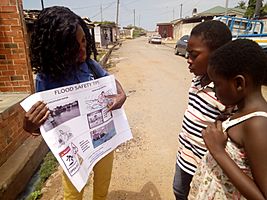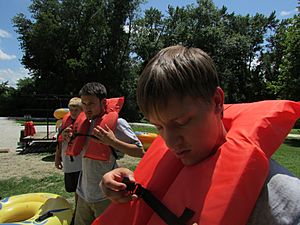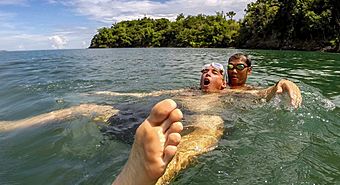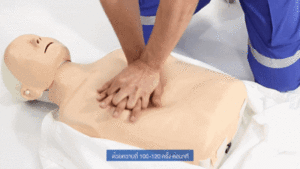Drowning facts for kids

Drowning occurs when a person spends too much time with their nose and mouth submerged in a liquid to the point when they can no longer breathe. Most instances of fatal drowning take place in situations where those present are either unaware of the victim's situation or unable to offer assistance.
Risk factors for drowning include epilepsy, minimal swim training or a complete lack of training, and, in the case of children, a lack of supervision. Common drowning locations include natural and man-made bodies of water, bathtubs, and swimming pools.
While the word "drowning" is commonly associated with fatal results, drowning may be classified into three different types: drowning that results in death, drowning that results in long-lasting health problems, and drowning that results in no health complications. Sometimes the term "near-drowning" is used in the latter cases.
Steps to prevent drowning include teaching children and adults to swim and to recognise unsafe water conditions, never swimming alone, use of personal flotation devices on boats and when swimming in unfavourable conditions, limiting or removing access to water (such as with fencing of swimming pools), and exercising appropriate supervision. Treatment of victims who are not breathing should begin with opening the airway and providing five breaths of mouth-to-mouth resuscitation. Cardiopulmonary resuscitation (CPR) is recommended for those who have been underwater for less than an hour and whose heart has stopped beating.
After successful resuscitation, drowning victims may experience breathing problems, vomiting, confusion, or unconsciousness. Occasionally, victims may not begin experiencing these symptoms until several hours after they are rescued. Inhaled fluid can act as an irritant inside the lungs. Even small quantities can cause the extrusion of liquid into the lungs (pulmonary edema) over the following hours; this reduces the ability to exchange the air and can lead to a person "drowning in their own body fluid." Vomit and certain poisonous vapors or gases (as in chemical warfare) can have a similar effect. The reaction can take place up to 72 hours after the initial incident and may lead to a serious injury or death.
In many countries, drowning is one of the biggest causes of death for children under 14 years old.
Approximately 90% of drownings take place in freshwater (rivers, lakes, and a relatively small number of swimming pools); the remaining 10% take place in seawater. Drownings in other fluids are rare and often related to industrial accidents. In New Zealand's early colonial history, so many settlers died while trying to cross the rivers that drowning was called "the New Zealand death."
Prevention


It is estimated that more than 85% of drownings could be prevented by supervision, training in water skills, technology, and public education.
- Surveillance: Watching the swimmers is a basic task, because drownings can be silent and unnoticed: a person drowning may not always be able to attract attention, often because they have become unconscious. Surveillance of children is important. The highest rates of drowning globally are among children under five, and young children should be supervised, regardless of whether they can already swim. The danger increases when they are alone. A baby can drown in the bathtub, in the toilet, and even in a small bucket filled with less than an inch of water. It only takes around 2 minutes underwater for an adult to lose consciousness, and only between 30 seconds and 2 minutes for a small child to die. Choosing supervised swimming places is safer. Many pools and bathing areas either have lifeguards or a pool safety camera system for local or remote monitoring, and some have computer-aided drowning detection. Bystanders are also important in detection of drownings and in notifying them (personally or by phone, alarm, etc.) to lifeguards, who may be unaware if distracted or busy. Evidence shows that alarms in pools are poor for any utility. The World Health Organization recommends analyzing when the most crowded hours in the swimming zones are, and to increase the number of lifeguards at those moments.
- Learning to swim: Being able to swim is one of the best defenses against drowning. It is recommended that children learn to swim in a safe and supervised environment when they are between 1 and 4 years old. Learning to swim is also possible in adults by using the same methods as children. It's still possible to drown even after learning to swim (because of the state of the water and other circumstances), so it's recommended to choose swimming places that are safe and kept under surveillance.
- Additional education: The WHO recommends training the general public in first-aid for the drowned, cardiopulmonary resuscitation (CPR), and to behave safely when in the water. It is recommended to teach those who cannot swim to keep themselves away from deep waters.
- Pool fencing: Every private and public swimming pool should be fenced and enclosed on every side, so no person can access the water unsupervised. The "Raffarin law", applied in France in 2003, forced the fencing of pools.
- Pool drains: Swimming pools often have drainage systems to cycle the water. Drains without covers can injure swimmers by trapping hair or other parts of the body, leading to immobilization and drowning. Drains should not suction too strongly. It is recommended for a pool to have many small drainage holes instead of a single large one. Periodic revisions are required to certify that the system is working well.
- Caution with certain conditions: Some conditions require one to be cautious when near water. For example, epilepsy and other seizure disorders may increase the possibility of drowning during a convulsion, making it more dangerous to swim, dive, and bathe. It is recommended that people with these conditions take showers rather than baths and are taught about the dangers of drowning.
- Lifejacket use: Children that cannot swim and other people at risk of drowning should wear a fastened and well-fitting lifejacket when near or in the water. Other flotation devices (inflatable inner tubes, water wings, foam tubes, etc.) may be useful, although they are usually considered toys. Other flotation instruments are considered safe, like the professional circle-shaped lifebuoy (hoop-buoy, ring-buoy, life-ring, life-donut, lifesaver, or life preserver), which is designed to be thrown, and some other professional variants that are used by lifeguards in their rescues.
- Depth awareness: Diving accidents in pools can cause serious injury. Up to 21% of shallow-water diving accidents can cause spinal injury, occasionally leading to death. Between 1.2% and 22% of all spinal injuries are from diving accidents. If the person does not die, the injury could cause permanent paralysis.
- Avoid dangerous waters: Avoid swimming in waters that are too turbulent, where waves are large, with dangerous animals, or are too cold. Also avoid dragging currents, which are currents that are turbulent, foamy, and that can drag people or debris. If caught by one of these currents, swim out from it (it is possible to move out gradually, in a diagonal direction until you arrive at the shore).
- Navigating safely: Many people who die by drowning die in navigation accidents. Safe navigation practices include being informed of the state of the sea and equipping the boat with regulatory instruments to keep people afloat. These instruments are lifejackets (see 'lifejacket use' above) and professional lifebuoys with the shape of a circle (ring-buoy, hoop-buoy, life-ring, life-donut, lifesaver, or life preserver).
- Use the "buddy system": Don't swim alone, but with another person who can help in case of a problem.
- Rescue robots and drones: Nowadays, there exist some remote-controlled modern devices that can accomplish a water rescue. Floating rescue robots can move across the water, allowing the victim to hold on to the drone and be moved out of the water. Flying drones are very fast and can drop life jackets from air, and may help to locate the victim’s position.
- Follow the rules: Many people who drown fail follow the safety guidelines of the area. It is important to pay attention to the signage that indicates whether swimming is allowed or if a lifeguard is on duty. (lifeguards, coastguards, etc.)
Time limits
The time a person can safely stay underwater depends on many factors, including energy consumption, number of prior breaths, physical condition, and age. An average person can last between one and three minutes before falling unconscious and around ten minutes before dying.
Management
Rescue
When a person is drowning or a swimmer becomes missing, a fast water rescue may become necessary to take that person out of the water as soon as possible. Drowning is not necessarily violent or loud, with splashing and cries; it can be silent.
Rescuers should avoid endangering themselves unnecessarily; whenever it is possible, they should assist from a safe ground position, such as a boat, a pier, or any patch of land near the victim. The fastest way to assist is to throw a buoyant object (such as a lifebuoy). It is very important to avoid aiming directly at the victim, since even the lightest lifebuoys weight over 2 kilograms, and can stun, injure or even render a person unconscious if they impact on the head. Alternatively, one could try to pull the victim out of the water by holding out an object to grasp. Some examples include: ropes, oars, poles, one's own arm, a hand, etc. This carries the risk of the rescuer being pulled into the water by the victim, so the rescuer must take a firm stand, lying down, as well as securing to some stable point. Alternatively, there are modern flying drones that drop life jackets.
Bystanders should immediately call for help. A lifeguard should be called, if present. If not, emergency medical services and paramedics should be contacted as soon as possible. Less than 6% of people rescued by lifeguards need medical attention, and only 0.5% need CPR. The statistics worsen when rescues are made by bystanders.
If lifeguards or paramedics are unable to be called, bystanders must rescue the drowning person. Alternatively, there are small floating robots that can reach the victim, as human rescue carries a risk for the rescuer, who could be drowned. Death of the would-be rescuer can happen because of the water conditions, the instinctive drowning response of the victim, the physical effort, and other problems.
After reaching the victim, first contact made by the rescuer is important. A drowning person in distress is likely to cling to the rescuer in an attempt to stay above the water surface, which could submerge the rescuer in the process. To avoid this, it is recommended that the rescuer approaches the panicking person with a buoyant object or extending a hand, so the victim has something to grasp. It can even be appropriate to approach from behind, taking one of the victim's arms, and pressing it against the victim's back to restrict unnecessary movement. Communication is also important.
If the victim clings to the rescuer and the rescuer cannot control the situation, a possibility is to dive underwater (as drowning people tend to move in the opposite direction, seeking the water surface) and consider a different approach to help the drowning victim. It is possible that the victim has already sunk beneath the water surface. If this has happened, the rescue requires caution, as the victim could be conscious and cling to the rescuer underwater. The rescuer must bring the victim to the surface by grabbing either (or both) of the victim's arms and swimming upward, which may entice the victim to travel in the same direction, thus making the task easier, especially in the case of an unconscious victim. Should the victim be located in deeper waters (or simply complicates matters too much) the rescuer should dive, take the victim from behind, and ascend vertically to the water surface holding the victim.
Finally, the victim must be taken out of the water, which is achieved by a towing maneuver. This is done by placing the victim body in a face-up horizontal position, passing one hand under the victim's armpit to then grab the jaw with it, and towing by swimming backwards. The victim's mouth and nose must be kept above the water surface.
If the person is cooperative, the towing may be done in a similar fashion with the hands going under the victim's armpits. Other styles of towing are possible, but all of them keeping the victim's mouth and nose above the water.
Unconscious people may be pulled in an easier way: pulling on a wrist or on the shirt while they are in a face-up horizontal position. Victims with suspected spinal injuries can require a more specific grip and special care, and a backboard (spinal board) may be needed for their rescue.
For unconscious people, an in-water resuscitation could increase the chances of survival by a factor of about three, but this procedure requires both medical and swimming skills, and it becomes impractical to send anyone besides the rescuer to execute that task. Chest compressions require a suitable platform, so an in-water assessment of circulation is pointless. If the person does not respond after a few breaths, cardiac arrest may be assumed, and getting them out of the water becomes a priority.
First aid
The checks for responsiveness and breathing are carried out with the person horizontally supine. If unconscious but breathing, the recovery position is appropriate. If not breathing, rescue ventilation is necessary. Drowning can produce a gasping pattern of apnea while the heart is still beating, and ventilation alone may be sufficient. The airway-breathing-circulation (ABC) sequence should be followed, rather than starting with compressions as is typical in cardiac arrest, because the basic problem is lack of oxygen. If the victim is not a baby, it is recommended to start with 5 normal rescue breaths, as the initial ventilation may be difficult because of water in the airways, which can interfere with effective alveolar inflation. Thereafter, a continual sequence of 2 rescue breaths and 30 chest compressions is applied. This alternation is repeated until vital signs are re-established, the rescuers are unable to continue, or advanced life support is available.
For babies (very small sized infants), the procedure is slightly modified. In each sequence of rescue breaths (the 5 initial breaths, and the further series of 2 breaths), the rescuer's mouth covers the baby's mouth and nose simultaneously (because a baby's face is too small). Besides, the intercalated series of 30 chest compressions are applied by pressing with only two fingers (due to the body of the baby being more fragile) on the chest bone (approximately on the lower part).
Methods to expel water from the airway such as abdominal thrusts, Heimlich maneuver or positioning the head downwards should be avoided, due to there being no obstruction by solids, and they delay the start of ventilation and increase the risk of vomiting.The risk of death is increased, as the aspiration of stomach contents is a common complication of resuscitation efforts.
Treatment for hypothermia may also be necessary. However, in those who are unconscious, it is recommended their temperature not be increased above 34 degrees C. Because of the diving reflex, people submerged in cold water and apparently drowned may revive after a long period of immersion. Rescuers retrieving a child from water significantly below body temperature should attempt resuscitation even after protracted immersion.
Medical care
People with a near-drowning experience who have normal oxygen levels and no respiratory symptoms should be observed in a hospital environment for a period of time to ensure there are no delayed complications. The target of ventilation is to achieve 92% to 96% arterial saturation and adequate chest rise. Positive end-expiratory pressure will improve oxygenation. Drug administration via peripheral veins is preferred over endotracheal administration. Hypotension remaining after oxygenation may be treated by rapid crystalloid infusion. Cardiac arrest in drowning usually presents as asystole or pulseless electrical activity. Ventricular fibrillation is more likely to be associated with complications of pre-existing coronary artery disease, severe hypothermia, or the use of epinephrine or norepinephrine.
While surfactant may be used, no high-quality evidence exist that looks at this practice. Extracorporeal membrane oxygenation may be used in those who cannot be oxygenated otherwise. Steroids are not recommended.
Images for kids
See also
 In Spanish: Ahogamiento para niños
In Spanish: Ahogamiento para niños










